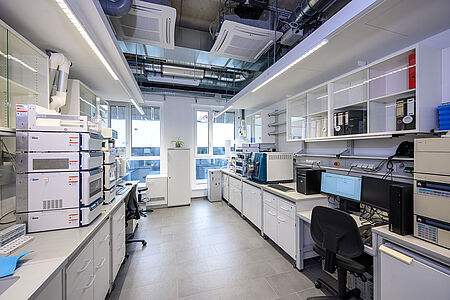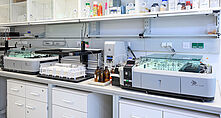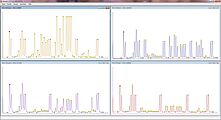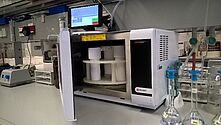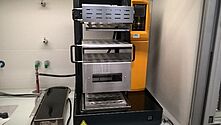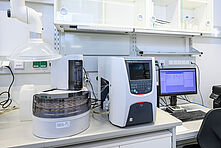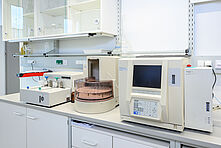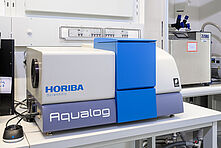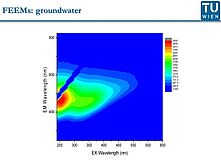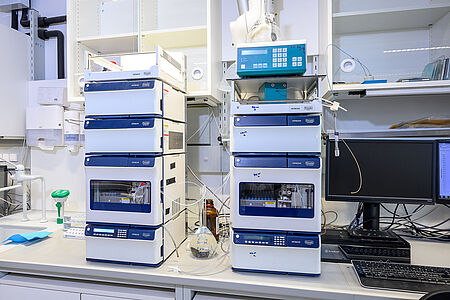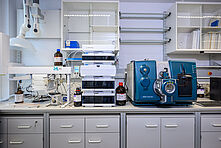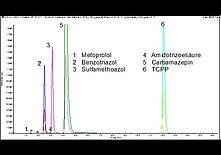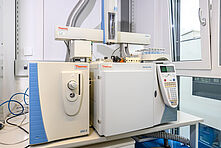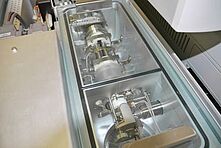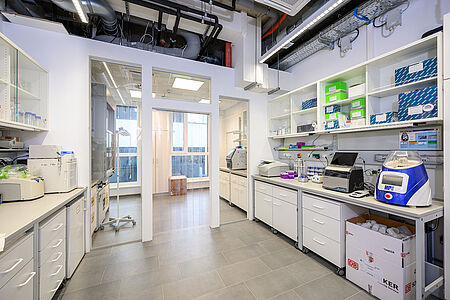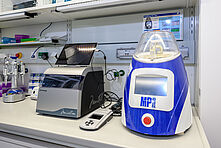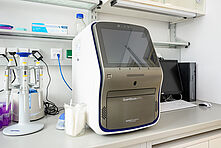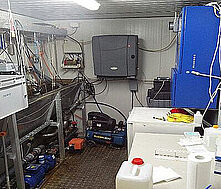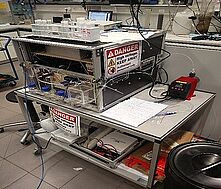Laboratory
The laboratory of the institute is located on the second floor of the Wasserforschungslabor at TU Wien, Lilienthalgasse 21, Object OD.
The main tasks of the laboratory are the accompanying investigations of the projects worked on at the institute and to a small extent contract analysis. The laboratory carries out routine investigations of ground, surface and wastewater as well as analyses of gas and solid samples.
The laboratory is also equipped for special investigations and for the preparation of expert opinions. Due to the constantly increasing number of new projects, new demands are constantly being placed on the analysis in our laboratory. Therefore a permanent introduction of new analytical methods, development of new parameters and the use of modern high-tech equipment is necessary.
Laboratory equipment
Our laboratory consists of three areas of competence:
- chemical-physical laboratory,
- molecular-biological laboratory and
- Research lab.
In this linked file you will find the extensive list of applied methods and investigated parameters: ![]() Link Methods and Parameter
Link Methods and Parameter
Nutrient analysis
The nutrient analysis (e.g. NH4, NO3, NO2, TP, TN, TKN) is mainly carried out with the San++ Continuous-Flow Analyser from Skalar. Four different parameters (NH4, NO3, NO2 and PO4) are measured simultaneously from one sample using colorimetric methods.
The SAN++ software package controls the entire analyser and supports automatic calculation of results, reporting, statistical evaluation and quality control.
The oxidative digestion for the determination of total bound nitrogen (TN) or total bound phosphorus (TP) is performed by oxidative microwave digestion with an instrument from the company Berghof.
Determination of Kjeldahl nitrogen (TKN) and total phosphorus (TP) in particle-rich samples is performed with a Kjeldahl digestion block with 36 digits (up to 400°C) from Gerhardt. The subsequent colorimetric determination of ammonium and phosphorus is performed with the continuous flow analyser.
Carbon analysis
For carbon analysis, in addition to the wet chemical methods (COD) and the BOD determination, a TOC analyser from Shimadzu is used. The device works with catalytic combustion oxidation at 680°C and can be used for the analysis of ultrapure water as well as highly polluted wastewater.
The instrument is equipped with additional modules for the determination of total bound nitrogen by chemiluminescence detection and a module for the determination of carbon in solid samples (sludge, sediments). The control, evaluation and quality assurance is possible by a software package from Shimadzu.
Fluorescence spectroscopy
Fluorescence spectroscopy examines the fluorescence of a sample when it is excited with UV light, visible light or light from the near infrared spectrum. Our laboratory is equipped with an Aqualog spectral fluorimeter (Fa Horiba), which simultaneously measures absorption spectra and fluorescence excitation emission matrices (EEM).
Ion chromatography
Analysis of organic trace substances
The impact of treated wastewater on the environment has been increasingly addressed in recent years. However, the analysis of standard parameters is not sufficient to describe the behaviour of various environmentally relevant substances such as pharmaceutically active substances, pesticides, hormones or even industrial and household chemicals.
For the investigation of environmentally relevant substances, which are often present in very low concentrations (ng/L), various sample preparation or chromatographic methods are used in the laboratory.
HPLC + Triple Quadrupole MS
GC
In addition to the determination of environmentally relevant substances such as OCP, PAH and nonylphenols, permanent gases (H2, CO2, N2O, O2, N2, CH4, CO) are analysed by gas chromatography.
The chromatographic separation of the samples is performed on a TRACE GC with split/splitless or PTV injector and Trace Autosampler, which is also equipped with headspace. Using different detectors such as TCD, ECD and a DSQ Single Quadrupole it is possible to determine a wide range of substances and to achieve low determination and detection limits.
Molecular Biology
In addition to chemical analyses, microbiological and molecular-biological investigations using completely new genetic methods or microscopic examinations are also used.
For sample preparation, devices such as an autoclave, a vacuum filtration unit and centrifuges are used. For the extraction and purification of DNA, RNA and proteins, a FastPrep Homogenizer from MP Biomedicals is used.
Online - measuring instruments
The monitoring of various chemical-physical parameters with on-line devices, both in wastewater treatment plants and in water bodies, is becoming increasingly important and has developed strongly over the last 20 years. The projects in this field are intensively supported by the laboratory and this enables the further development of methods and devices in cooperation with industrial partners.
Additional tasks
Administrative activities
A separate laboratory information system has been developed for administrative activities in the laboratory such as sample registration, archiving of measurement results and reporting. This facilitates the exchange of important data between the laboratory and its staff. A separate software has been developed for various methods such as oxygen consumption measurement of activated sludge.
Training and further education
In addition to analysis, the laboratory also has a training and further education function. On the one hand, new employees are to be familiarized with various analytical methods, on the other hand, interested students and trainees have the opportunity to receive further training in environmental analysis. Various training projects on a national and international (IAESTE, Erasmus etc.) level have been supported.
Contact
Head of Laboratories
Dipl.-Ing. Dr.techn.
Ernis Saracevic
Email: ![]() erni(at)iwag.tuwien.ac.at
erni(at)iwag.tuwien.ac.at
Tel.: +43 (0)1 58801 - 22660
Fax: +43 (0)1 58801 - 22698



